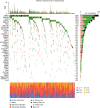Integration of whole-exome sequencing and structural neuroimaging analysis in major depressive disorder: a joint study
- PMID: 38461185
- PMCID: PMC10924915
- DOI: 10.1038/s41398-024-02849-4
Integration of whole-exome sequencing and structural neuroimaging analysis in major depressive disorder: a joint study
Abstract
Major depressive disorder (MDD) is a common mental illness worldwide and is triggered by an intricate interplay between environmental and genetic factors. Although there are several studies on common variants in MDD, studies on rare variants are relatively limited. In addition, few studies have examined the genetic contributions to neurostructural alterations in MDD using whole-exome sequencing (WES). We performed WES in 367 patients with MDD and 161 healthy controls (HCs) to detect germline and copy number variations in the Korean population. Gene-based rare variants were analyzed to investigate the association between the genes and individuals, followed by neuroimaging-genetic analysis to explore the neural mechanisms underlying the genetic impact in 234 patients with MDD and 135 HCs using diffusion tensor imaging data. We identified 40 MDD-related genes and observed 95 recurrent regions of copy number variations. We also discovered a novel gene, FRMPD3, carrying rare variants that influence MDD. In addition, the single nucleotide polymorphism rs771995197 in the MUC6 gene was significantly associated with the integrity of widespread white matter tracts. Moreover, we identified 918 rare exonic missense variants in genes associated with MDD susceptibility. We postulate that rare variants of FRMPD3 may contribute significantly to MDD, with a mild penetration effect.
© 2024. The Author(s).
Conflict of interest statement
The authors declare no competing interests.
Figures


Similar articles
-
A study combining whole-exome sequencing and structural neuroimaging analysis for major depressive disorder.J Affect Disord. 2020 Feb 1;262:31-39. doi: 10.1016/j.jad.2019.10.039. Epub 2019 Oct 31. J Affect Disord. 2020. PMID: 31706157
-
Whole-exome sequencing identifies variants associated with structural MRI markers in patients with bipolar disorders.J Affect Disord. 2019 Apr 15;249:159-168. doi: 10.1016/j.jad.2019.02.028. Epub 2019 Feb 11. J Affect Disord. 2019. PMID: 30772743
-
A joint study of whole exome sequencing and structural MRI analysis in major depressive disorder.Psychol Med. 2020 Feb;50(3):384-395. doi: 10.1017/S0033291719000072. Epub 2019 Feb 6. Psychol Med. 2020. PMID: 30722798
-
Neuroimaging Genomics a Predictor of Major Depressive Disorder (MDD).Mol Neurobiol. 2024 Jun;61(6):3427-3440. doi: 10.1007/s12035-023-03775-0. Epub 2023 Nov 22. Mol Neurobiol. 2024. PMID: 37989980 Review.
-
Molecular, Functional, and Structural Imaging of Major Depressive Disorder.Neurosci Bull. 2016 Jun;32(3):273-85. doi: 10.1007/s12264-016-0030-0. Epub 2016 May 3. Neurosci Bull. 2016. PMID: 27142698 Free PMC article. Review.
Cited by
-
Omics approaches open new horizons in major depressive disorder: from biomarkers to precision medicine.Front Psychiatry. 2024 Jun 13;15:1422939. doi: 10.3389/fpsyt.2024.1422939. eCollection 2024. Front Psychiatry. 2024. PMID: 38938457 Free PMC article. Review.
References
-
- Murray CJL, Vos T, Lozano R, Naghavi M, Flaxman AD, Michaud C, et al. Disability-adjusted life years (DALYs) for 291 diseases and injuries in 21 regions, 1990–2010: a systematic analysis for the global burden of disease study 2010. Lancet 2012. 10.1016/S0140-6736(12)61689-4. - PubMed
MeSH terms
Grants and funding
- 2020M3E5D9080792/National Research Foundation of Korea (NRF)
- 2022R1A2C2093009/National Research Foundation of Korea (NRF)
- 2020R1C1C1012288/National Research Foundation of Korea (NRF)
- 2022R1A2C4001313/National Research Foundation of Korea (NRF)
- 2020M3E5D9080792/National Research Foundation of Korea (NRF)
- 2022R1A2C2093009/National Research Foundation of Korea (NRF)
- 2020M3E5D9080792/National Research Foundation of Korea (NRF)
- 2022R1A2C2093009/National Research Foundation of Korea (NRF)
- 2022R1A2C4001313/National Research Foundation of Korea (NRF)
- 2020R1C1C1012288/National Research Foundation of Korea (NRF)
LinkOut - more resources
Full Text Sources

